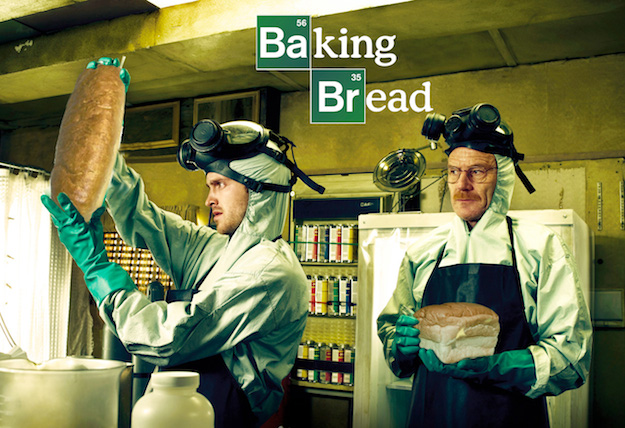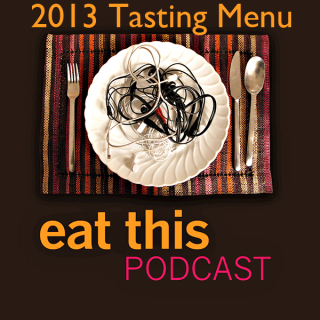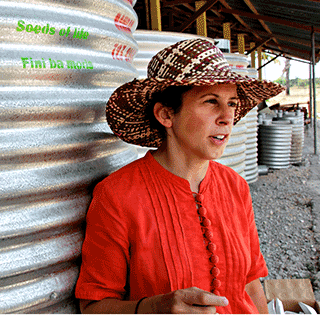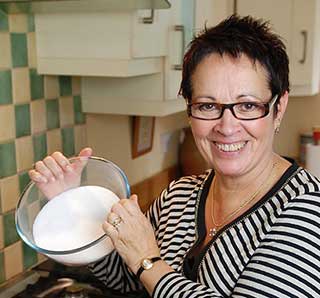Ah, the self-indulgent joy of making a podcast on one of my own passions.

“They” say that turning cooking from an enjoyable hobby into a business is a recipe for disaster, and while I’m flattered that people will pay for an additional loaf of bread I’ve baked, there’s no way I’m going to be getting up at 3 in the morning every day to sell enough loaves to make a living. But there are people who have done just that, and one of them happens to be a friend. Suzanne Dunaway and her husband Don turned her simple, delicious foccacia into Buona Forchetta bakery, a multi-million dollar business that won plaudits for the quality of its bread – and then sold it and walked away.
Podcast: Play in new window | Download (Duration: 20:42 — 19.0MB)
Subscribe: Google Podcasts | Spotify | Android | RSS | More
Suzanne was also one of the first popularisers of the “no-knead” method of making bread, with her 1999 book No need to knead. Using a wetter dough, and letting time take the place of kneading, has been around among professional bakers and some, often forgetful, amateurs for a long time, but it was Mark Bittman’s article in the New York Times that opened the floodgates on this method. Since then, as any search engine will reveal, interest in the technique has exploded, both because no-knead is perceived as easier and because the long, slow rise that no-knead usually calls for results in a deeper, more complex flavour. I’ve had my troubles with it, and had more or less given up on the real deal. But I’m looking forward to seeing how a quick no-knead bread turns out, especially now that I know that in Suzanne’s case it was the result of a delicious accident.
Notes
- If you created the graphic riff on Breaking Bad, or you know who did it, please let me know. I would really like to give proper credit.
 The first episode of 2014 is a look back to some of the topics I covered in 2013, and for what I hope is a good reason. With a podcast, unlike a piece of writing or an image, it is very hard to decide quickly whether this is something I want to pursue further. Of course some things are an instant turn-off: really bad audio quality will usually send me packing, as will a pile of unedited ramblings no matter how good the audio quality. Aside from that, though, it takes time to listen to a podcast and decide whether I want to hear more. With that in mind, I put together this tasting menu from 2013, to give new listeners an idea of what Eat This Podcast is about.
The first episode of 2014 is a look back to some of the topics I covered in 2013, and for what I hope is a good reason. With a podcast, unlike a piece of writing or an image, it is very hard to decide quickly whether this is something I want to pursue further. Of course some things are an instant turn-off: really bad audio quality will usually send me packing, as will a pile of unedited ramblings no matter how good the audio quality. Aside from that, though, it takes time to listen to a podcast and decide whether I want to hear more. With that in mind, I put together this tasting menu from 2013, to give new listeners an idea of what Eat This Podcast is about. Apologies for the delay in publishing this podcast. One of the joys of not being tied to “proper” radio is the freedom to give a story the length it deserves. The downside is that nobody is cracking the whip to whip things into shape on time, so that sometimes, even with the best will in the world, the schedule slips. Maybe if this were my day job …
Apologies for the delay in publishing this podcast. One of the joys of not being tied to “proper” radio is the freedom to give a story the length it deserves. The downside is that nobody is cracking the whip to whip things into shape on time, so that sometimes, even with the best will in the world, the schedule slips. Maybe if this were my day job … One week jam, the next global hunger and malnutrition. That’s the joy of Eat This Podcast; I get to present what interests me, in the hope that it interests you too. It also means I sometimes get to talk to my friends about how they see the big picture around food. Dr Jessica Fanzo, Assistant Professor of Nutrition at Columbia University’s Insitute of Human Nutrition, Special Advisor on Nutrition Policy at the Earth Institute’s Center on Globalization and Sustainable Development, also at Columbia, and much else besides, is one such friend. She was in Rome recently for a preparatory meeting for a big UN conference on nutrition next year, so I took the opportunity to catch up, and to ask some very basic questions about global hunger.
One week jam, the next global hunger and malnutrition. That’s the joy of Eat This Podcast; I get to present what interests me, in the hope that it interests you too. It also means I sometimes get to talk to my friends about how they see the big picture around food. Dr Jessica Fanzo, Assistant Professor of Nutrition at Columbia University’s Insitute of Human Nutrition, Special Advisor on Nutrition Policy at the Earth Institute’s Center on Globalization and Sustainable Development, also at Columbia, and much else besides, is one such friend. She was in Rome recently for a preparatory meeting for a big UN conference on nutrition next year, so I took the opportunity to catch up, and to ask some very basic questions about global hunger.